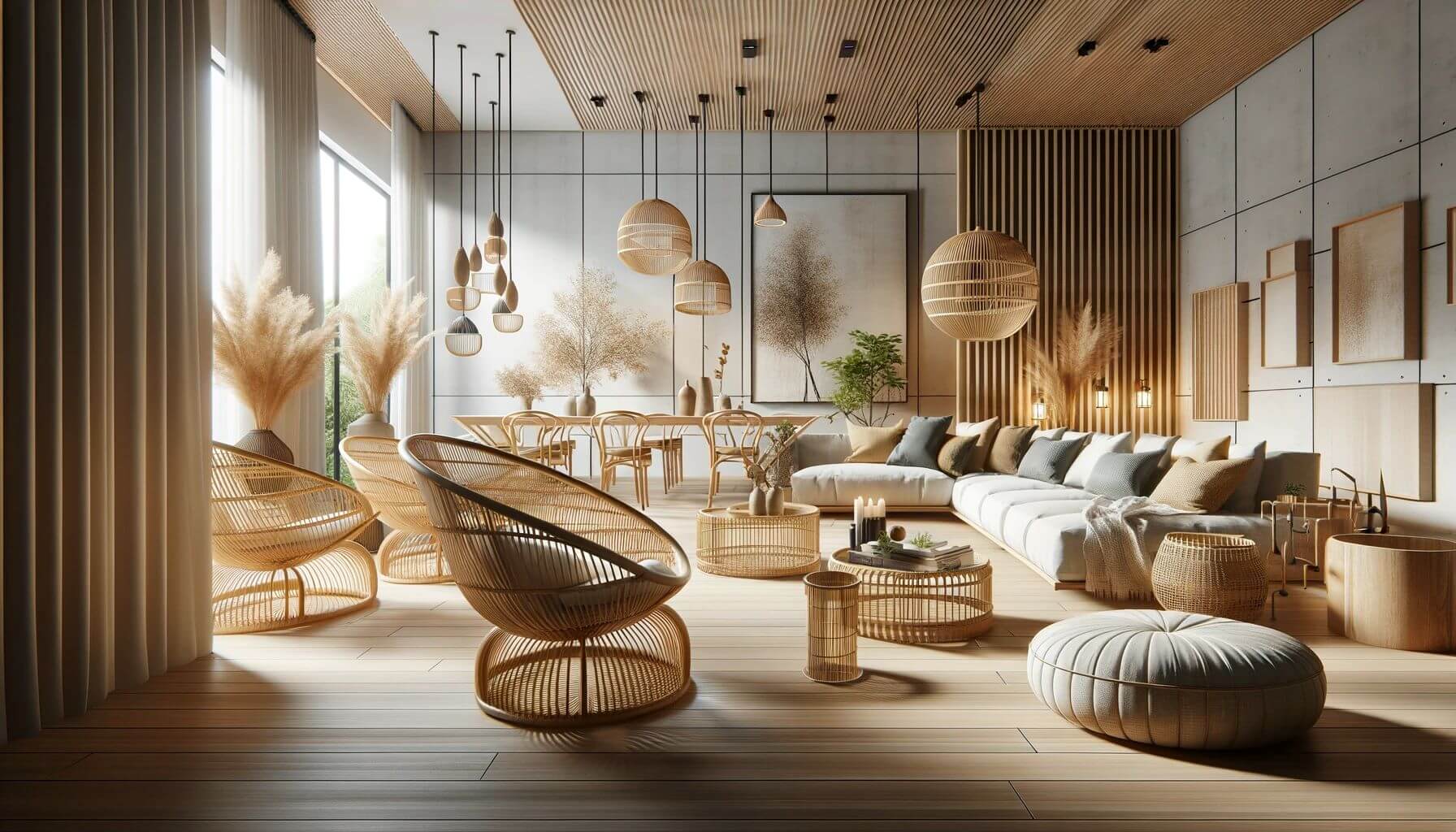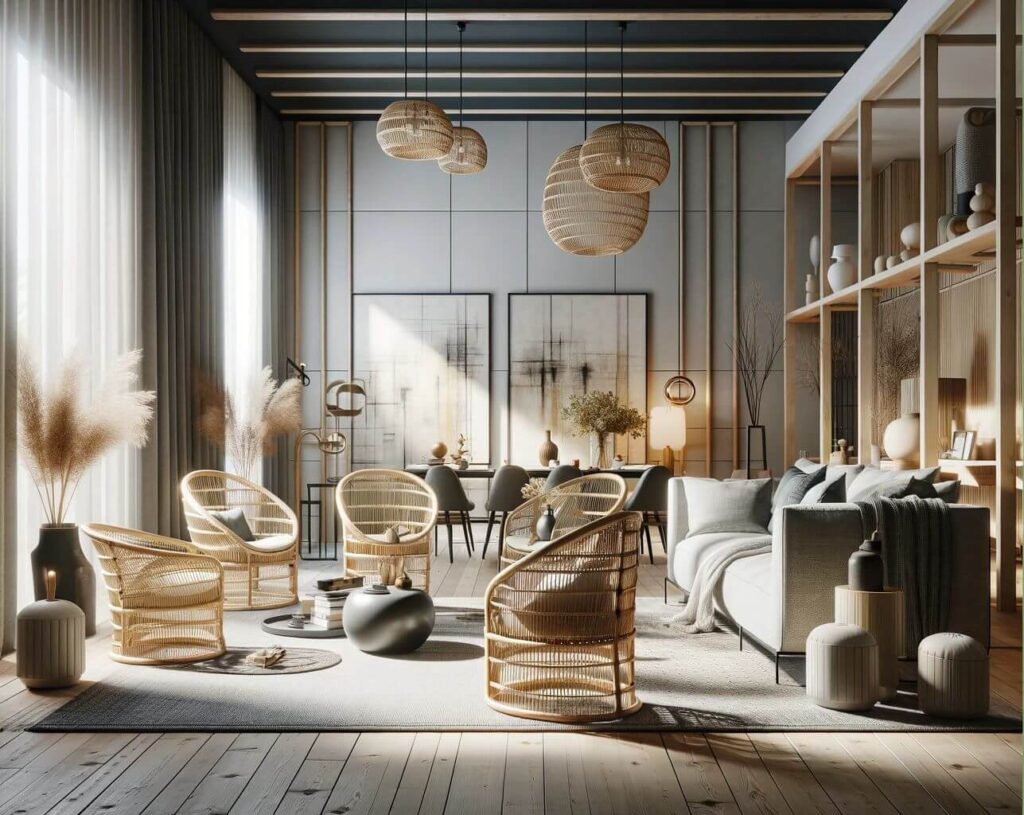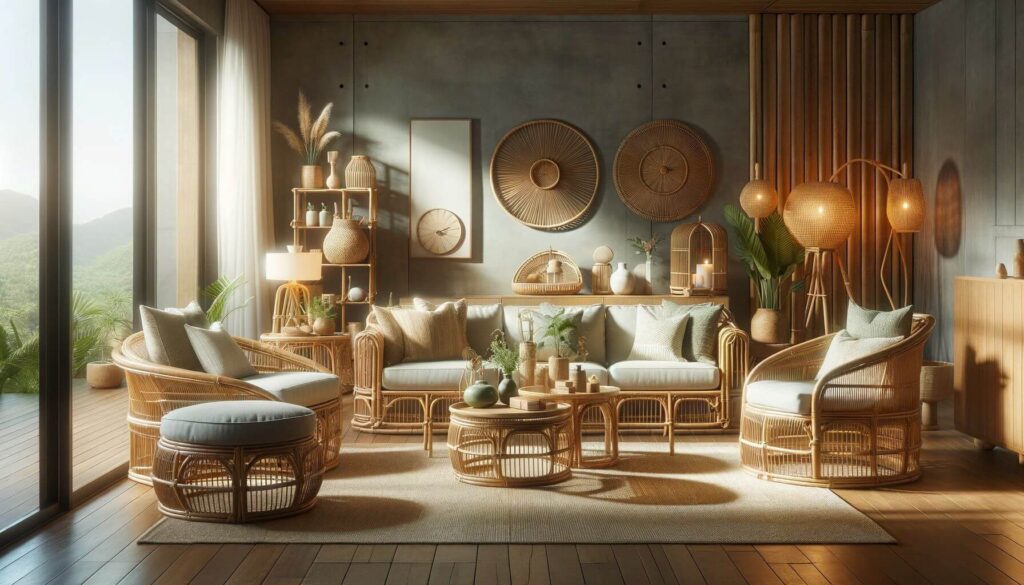
When it comes to outdoor furniture or boho-chic interiors, you’ve probably heard the terms “rattan” and “wicker” thrown around. But do you know what these terms really mean? Many people use them interchangeably, but there’s actually a big difference. Let’s explore the world of natural furniture and unravel the mystery of rattan and wicker.
Understanding rattan: The natural material
Rattan is a type of palm tree that grows in the tropical regions of Africa, Asia, and Australia. It’s a vine-like plant that can grow up to hundreds of feet long. The outer bark of rattan is peeled off and used to make wicker furniture, while the inner core is used to create solid rattan furniture.

Rattan furniture adds a natural, elegant touch to any living space.
Wicker: A weaving technique, not a material
On the other hand, wicker is not a material at all. It’s actually a weaving technique used to make furniture and other items. Wicker can be made from various materials, including rattan, bamboo, reed, willow, and even synthetic fibers. This is where the confusion often arises.
Strengths of rattan furniture
Rattan furniture is known for its strength and durability. It’s lightweight yet sturdy, making it perfect for both indoor and outdoor use. Rattan can be bent and shaped without breaking, allowing for a variety of furniture designs. For more information on incorporating rattan into your decor, check out our article on the charm of indoor rattan furniture.
Versatility of wicker
Wicker furniture, because it’s a weaving technique rather than a specific material, can be incredibly versatile. It can be made from natural materials for a bohemian look, or synthetic materials for increased durability outdoors. The woven pattern adds texture and interest to any piece of furniture.
Rattan vs. wicker: Appearance and texture
While both rattan and wicker furniture can have a similar appearance, there are some key differences. Rattan furniture often has a smoother, more polished look, especially when the solid core is used. Wicker furniture, on the other hand, always has a woven texture, which can range from tight and smooth to loose and rustic.
Durability and maintenance
When it comes to durability, solid rattan furniture often has the edge. It’s naturally resistant to splintering and breaking. Wicker furniture’s durability depends on the material used. Natural wicker requires more maintenance and is best suited for indoor use, while synthetic wicker can withstand outdoor conditions.
Rattan vs wicker in outdoor spaces
Both rattan and wicker furniture can be great choices for outdoor spaces, but with some considerations. Synthetic wicker is often the best choice for patios and decks as it’s weather-resistant. Natural rattan can be used outdoors but should be protected from direct sunlight and rain. For more outdoor furniture ideas, take a look at our guide on eco-friendly patio furniture.
Environmental impact of Rattan versus Wicker
Rattan is a fast-growing, renewable resource, making it an eco-friendly choice for furniture. However, the increasing demand has led to concerns about sustainable harvesting. Wicker, when made from natural materials, can also be environmentally friendly. Synthetic wicker, while durable, is not biodegradable.
Rattan and wicker in interior design
Furniture from these materials can add texture and a natural element to your interior design. They work well in various styles, from boho-chic to coastal to tropical. For ideas on incorporating these elements into your decor, check out our post on boho chic design ideas.
The cost factor

Generally, rattan furniture tends to be more expensive than wicker furniture. This is because rattan is a specific material that needs to be harvested and processed. Wicker, being a technique, can be made from less expensive materials, making it more budget-friendly.
Wicker vs Rattan beyond furniture
While we often think of furniture when discussing rattan and wicker, these materials and techniques can be used for much more. Rattan can be used for decorative elements like mirror frames or lamp bases. Wicker can be used for baskets, planters, and even wall decor. For creative decor ideas, see our article on bohemian outdoor wall decor.
The history of rattan and wicker
Both rattan and wicker have a rich history. Rattan has been used for thousands of years in Asia for everything from furniture to bridges. Wicker weaving dates back to ancient Egypt. Understanding this history can help you appreciate these materials even more.
How to choose between rattan and wicker
When deciding between rattan and wicker furniture, consider your specific needs. If you want durable, long-lasting furniture for indoor use, solid rattan might be the way to go. For outdoor furniture or if you’re on a budget, wicker could be the better choice. Either way, both can add a beautiful natural element to your space.
Caring for rattan furniture
To keep your rattan furniture looking its best, regular dusting is essential. You can use a soft brush or vacuum with a brush attachment. For deeper cleaning, use a mild soap solution and a soft cloth. Avoid getting rattan too wet, as this can lead to mold or mildew. For more furniture care tips, check out our guide on polywood furniture care.
Maintaining wicker furniture
Wicker furniture also requires regular dusting. For natural wicker, avoid getting it too wet. Synthetic wicker can be cleaned with a hose, making it easier to maintain. Always allow wicker furniture to dry completely to prevent mold growth.
Wicker versus Rattan in different climates
Climate plays a big role in how well rattan and wicker furniture will hold up. In humid climates, natural materials may be prone to mold or mildew. In very dry climates, natural rattan and wicker can become brittle. Consider your local climate when choosing between these materials.
Mixing rattan and wicker in your decor
Don’t be afraid to mix rattan and wicker pieces in your decor. They can complement each other beautifully, adding variety in texture and form. For ideas on mixing different elements in your outdoor space, see our post on design a Mediterranean outdoor.
Rattan and wicker in different rooms

While we often think of rattan and wicker in living rooms or outdoor spaces, they can work well in other rooms too. Consider a rattan headboard in the bedroom or wicker baskets in the bathroom for storage. These natural elements can add warmth to any space.
The future of rattan and wicker
As sustainability becomes more important in furniture production, we may see changes in how rattan is harvested and processed. We’re also likely to see more innovations in synthetic wicker materials, making them even more durable and eco-friendly.
Rattan and wicker alternatives
If you love the look of rattan and wicker but want to explore other options, consider materials like bamboo or seagrass. These can provide a similar natural aesthetic. For more ideas on incorporating natural elements in your decor, check out our article on plants for contemporary landscape.
Rattan and wicker in commercial spaces
Rattan and wicker furniture isn’t just for homes. Many restaurants, hotels, and other commercial spaces use these materials to create a relaxed, inviting atmosphere. If you’re designing a commercial space, consider how rattan or wicker could fit into your design.
Customizing rattan and wicker furniture
One of the great things about rattan and wicker furniture is that it’s easy to customize. You can paint it to match your decor or add cushions for extra comfort and style. This flexibility allows you to keep your furniture fresh and on-trend.
Rattan and wicker in different design styles
While often associated with boho or tropical styles, rattan and wicker can work in many design aesthetics. They can add warmth to a modern space, texture to a minimalist room, or complement a rustic design. For more on incorporating different styles, see our guide on Scandinavian design.
The comfort factor
When it comes to comfort, they are both can be excellent choices. The natural flexibility of rattan allows for ergonomic designs. Wicker’s woven texture can be comfortable on its own, and the addition of cushions can make these pieces even more cozy.
Rattan and wicker accessories
Beyond furniture, consider incorporating rattan and wicker through accessories. Wicker baskets can provide stylish storage, while rattan light fixtures can add a natural touch to your lighting. These small additions can make a big impact on your overall decor.
Rattan and wicker in vintage decor
Both rattan and wicker have been popular in furniture making for decades, making them perfect for vintage-inspired decor. Look for antique pieces to add character to your space. For more vintage decor ideas, check out our post on vintage out space.
The global influence of rattan and wicker
Rattan and wicker techniques are used in furniture making around the world, each region adding its own unique twist. From Scandinavian designs to tropical Asian styles, exploring these global influences can add depth to your decor choices.
Rattan, wicker, and sustainability
As we become more conscious of our environmental impact, the sustainability of our furniture choices becomes more important. Both rattan and natural wicker can be sustainable choices when sourced responsibly. For more on eco-friendly decor, see our article on eco-friendly building materials.
Embracing natural beauty in your decor
Whether you choose rattan, wicker, or a combination of both, these natural elements can add warmth, texture, and style to your space. Understanding the differences between rattan and wicker allows you to make informed decisions about your furniture and decor choices. Remember, there’s no strict rule saying you have to choose one or the other. Both have their place in beautiful, comfortable interiors and exteriors. So go ahead, embrace the natural beauty of these materials and create a space that’s uniquely yours.



